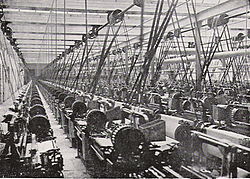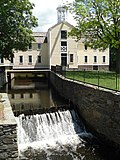Cotton mill
A cotton mill is a building with spinning or weaving machinery to make yarn or cloth from cotton. Cotton mills were among the early factories in the Industrial Revolution.
Some of the earliest mills were driven by animals. Most early mills were built by rivers and streams using water wheels for power. Boulton and Watt started making powerful steam engines in1781. This led to the growth of larger, steam-powered mills in mill towns, like Manchester and Salford which had more than 50 mills by 1802.[1]

The new jobs in the mills pulled people in from country areas and made the towns and cities grow. At first they often employed children. That was stopped by the Factory Acts. Many of the first mills were in Lancashire but they spread to the rest of the world. In 1860, there were 2650 cotton mills in Lancashire, employing 440,000 people.
In the twentieth century the mills changed to electric power. Many of them closed and those which are still working are mostly automated, with many fewer workers. Many of the large buildings are still standing.
Cotton Mill Media
Marvel's Mill in Northampton, pictured in 1746 – the earliest known pictorial representation of a cotton mill
Richard Arkwright's first 1771 Cromford Mill in Derbyshire, with three of its original five storeys remaining
Old Mill, built as a steam-powered mill in Ancoats in 1798, is the oldest surviving cotton mill in Manchester.
Slater's Mill in Pawtucket, Rhode Island, built in 1790
William Fairbairn's Lancashire boiler
Central office and warehouse block, Houldsworth Mill, Reddish
References
- ↑ Thompson, F. M. L. (1993), "Town and city", in Thompson, F. M. L. (ed.), The Cambridge Social History of Britain, 1750–1950: Regions and Communities, Cambridge: Cambridge University Press, pp. 27–28, ISBN 0-521-43816-0, retrieved 2013-12-07









